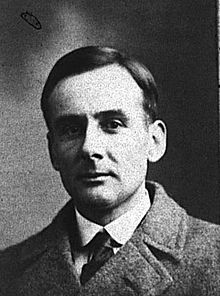Joseph Boxhall
| Joseph Groves Boxhall Jr. | |
|---|---|
 |
|
| Born |
23 March 1884 Hull, East Riding of Yorkshire, England, U.K. |
| Died | 25 April 1967 (aged 83) Christchurch, Dorset, England, U.K. |
Commander Joseph Groves Boxhall RD (23 March 1884 – 25 April 1967) was the fourth officer on the RMS Titanic, and later served as a naval officer in World War I.
Boxhall was born in Hull in the East Riding of Yorkshire, England, the second child of Miriam and Captain Joseph Boxhall, Sr. He was born into an established seafaring tradition: His grandfather had been a mariner, his uncle was a Trinity House buoymaster and Board of Trade official, and his father was a respected master with the Wilson Line of Hull.
Boxhall followed in the footsteps of his ancestors on 2 June 1899, when he joined his first ship, a barque of the William Thomas Line of Liverpool. Boxhall's apprenticeship lasted four years, during which time he travelled extensively. He then went to work with his father at Wilson Line and, after obtaining his Master's and Extra-Master's certifications in September 1907, joined the White Star Line. On 1 October 1911, he was confirmed as a sub-lieutenant in the Royal Naval Reserve. He served on White Star's liners RMS Oceanic and Arabic before moving to the Titanic as Fourth Officer in 1912; he was then 28 years old.
Like the ship's other junior officers, Boxhall reported to White Star's Liverpool offices at nine o'clock in the morning on 26 March 1912, and travelled to board the ship at Belfast the following day. After the RMS Titanic departed Southampton on 10 April, Boxhall settled into his regular duties; these included scheduled watches, aiding in navigation, and assisting passengers and crew when necessary.
When Titanic collided with an iceberg at 11.40 PM on 14 April, Officer Boxhall was off duty near the Officers' Quarters. Hearing the lookout bell, he headed immediately to the bridge, arriving just after the impact. Capt. Smith, who had also just arrived on the bridge, ordered Boxhall to perform an inspection of the forward part of the ship. He found no damage, but was later intercepted by the ship's carpenter, who informed him that the ship was taking water. A mail clerk confirmed this to Boxhall and Captain Smith. Later, it was Boxhall who calculated the Titanic's position so that a distress signal could be sent out. It was also Boxhall who sighted the masthead lights of a nearby vessel (possibly the SS Californian) and attempted in vain to signal by Morse lamp and distress flares.
...
Wikipedia
